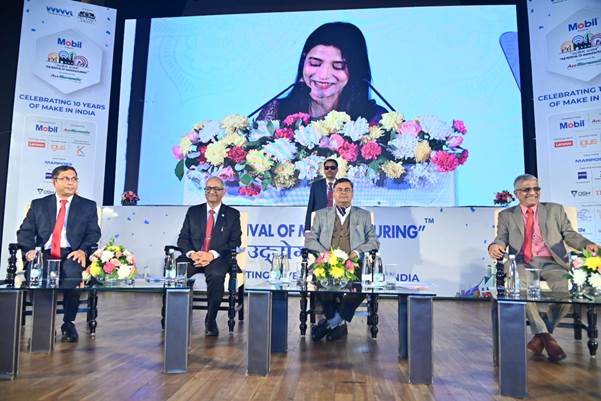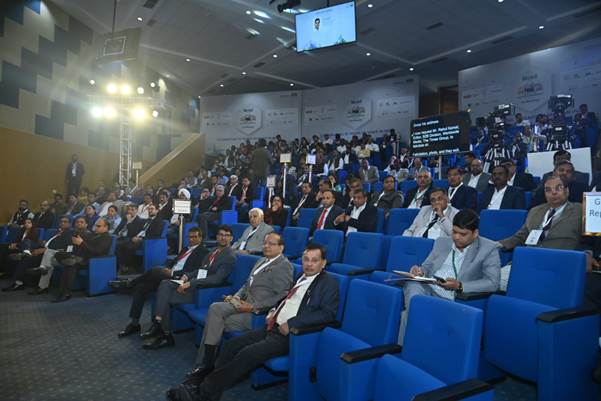The Union Minister for Power and New & Renewable Energy Shri R. K. Singh has exhorted the Indian manufacturing industry to embrace the challenge of being able to compete globally, to make in India not only for India but for the world. The Minister said this, while addressing the 2nd edition of The Times Group WorldWide Media Festival of Manufacturing 2024, in New Delhi today, March 7, 2024.

The Minister said that the Indian industry needs to look around to compete in external markets and be able to export. “There is no country which can be fully self-sufficient; every country needs to import something, for which you need to be able to sell to that country, which in turn needs quality, finishing and product improvement. This is what the industry did not do in the era of licensing.”
The Minister said the industry representatives that the quality of their products needs to be so good that they are able to compete globally and that their prices need to be reasonable. “Ultimately, you have to compete, and the people are not going to suffer while you give them outdated or bad-quality equipment or high prices.”
“The world is looking at China plus one, we want to be that one”
The Union Minister added that we are also open to people coming and setting up industry in India. “We want the manufacturing to come here. The world is looking at China plus one, we want to be that one.”
“Rs. 20 lakh crores invested in the power sector during last ~9 years, another Rs. 17 lakh crores in next 5 – 7 years”
Reflecting on challenges faced historically by the manufacturing sector, the Minister said that there has never been a dearth of demand, but that the pace of growth brought in by the government has multiplied the demand manifold. Speaking about the power sector, he said that the government has invested about Rs. 20 lakh crores in the power sector during the last ~9 years, and that another Rs. 17 lakh crores will be invested in the next 5 – 7 years. “In the last ~10 years, we have added 190 GW of power generation capacity, increasing it to around 436 GW, nearly doubling it. This required a lot of thermal and renewable equipment. We added 200,000 circuit kilometres to transmission lines; our transmission system today is the largest integrated transmission system in the world. We can transfer 116 GW from one corner of the country to another. During my tenure, we spent about Rs. 2 lakh crores in constructing about 3,000 new substations, upgrading about 4,000 substations, adding 8.5 lakh circuit kilometres of HT and LT lines and 7.5 lakh transformers.”

The Power Minister said that the expansion is going on and that we need to double the size by 2030, given the quantum of power we need. “The power demand grew by 60% from 2013-14, it grew by 9% last year, but we were able to meet it due to the expansion and upgradation in infrastructure we did. We are adding about 85 GW of thermal capacity, we have 14 GW hydro under construction and another 14 – 15 GW of hydro capacity under clearances.”
The Minister recalled that viability of discoms was an issue which earlier stood in the way of addition of power capacity. “Earlier, we had about 60 GW under NCLT, but today, all power sector companies have doubled or tripled their share prices, and their market caps have gone up 3-4 times, indicating how viable they have become. We have brought down AT&C losses from ~27% in 2014 to ~15% and the next year, it will be ~12%. We have ensured subsidy payments are paid on time, and have improved billing and collection efficiencies. And investments are coming in.”
The Minister said that the nation is going to add thermal capacity, since we are not going to compromise on availability of power for growth. “Energy security is number one priority, and energy transition is number two, though we are a world leader in energy transition already. Our per capita emissions are already one third of global average. We are the only major economy which has achieved both its NDCs well ahead of time.”
The Power and NRE Minister informed the industry that there was a time when he felt we had surplus power capacity, but when the economy started expanding, the demand started increasing and the government had to decide to add further capacity. “We had added lot of renewable capacity, but we don’t have solar power at the night and storage is expensive. The developed world was not serious about transition; they did not add adequate energy storage capacity. The price, when we bid out for storage, was Rs. 10 per kilowatt hour, which was not viable. So, we decided to add thermal capacity and we are going to add storage capacity so that it becomes viable. We are going to come up with bids for 4,000 MW of storage capacity, and we have also started ~ 50 GW of Pumped Storage Projects at different stages.”
“Power sector is growing and creating demand, we want that demand to be met by Made in India”
Speaking about the growth of the power sector which is creating demand, the Minister said that the government wants that demand to be met by Made in India, for which the manufacturing capacity required is huge. “We have already put in place policy instruments, such as a tariff barrier of 40% on modules, and barrier of 25% on cells, so that industry is protected. We have put quality barriers, so that externally manufactured equipment takes time to qualify. Today, our module manufacturing capacity has gone up from 20 GW to 50 GW, and cell manufacturing capacity from 2 GW to around 12 – 13 GW.”
Recollecting the importance of manufacturing and the support extended to industry, the Minister said that the power sector started early on, giving a playing field by protecting the industry. “In 2018, we came out with a circular saying that every imported equipment needs to undergo strenuous tests. For thermal equipment, we started the phased manufacturing programme, encouraging domestic manufacturing. We started transitioning at a rapid pace. The pace of renewable energy capacity addition in India is the highest in the world, as per IEA. Our non-fossil capacity is about 186 GW, out of which 7 GW is nuclear and the remaining is solar, wind, hydro.”
The Power Minister said that the orientation of the government has been changed, to that of solving problems. He cited examples of measures taken to encourage more fiscal prudence on the part of states. “We have already started to bring in instruments which will make states more fiscally prudent. For example, we have said that subsidies given by states have to be paid for. We have said that states can give free electricity but that they need to pay generation companies; genco dues are now totally up to date. Legacy dues have come down from Rs. 1.35 lakh crores to Rs. 44,000 crores.”
The 2nd edition of the Festival of Manufacturing celebrates ‘10 years of Make in India’, to celebrate the progress made in the last decade, highlight success stories and chart the way forward for India’s manufacturing sector. Organized by The Machinist, The Times Group’s B2B magazine for the Manufacturing sector, the event aims to be a stage where the government and private sector can highlight their policies, investment opportunities, growth trajectories and their vision for India at 2047.



Comments are closed.